|
|
General J.H. Doolittle
Tokyo Raiders Reunion, 2003
|
|
Piper L-4 “Grasshopper”
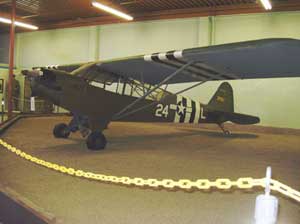
Piper L-4 “Grasshopper”
The L-4A liaison aircraft, originally designated the O-59, was the military version of the famous Piper J3 "Cub." The Army ordered the first O-59s in 1941 for tests in conjunction with its growing interest in the use of light aircraft for liaison and observation duties in direct support of ground forces. Between 1941 and 1945, the Army procured almost 6,000 Piper Aircraft.
During WW II, "Grasshoppers" performed a wide variety of functions throughout the world such as for spotting artillery fire direction, pilot training, glider pilot instruction, courier service and front-line liaison.
Specifications:
- Span: 35 ft. 3 in.
- Length: 22 ft. 5 in.
- Height: 6 ft. 8 in.
- Weight: 1,200 lbs. maximum
- Armament: None
- Engine: Continental O-170 of 65 hp.
- Maximum speed 85 mph.
- Cruising speed: 75 mph.
- Range: 190 miles
- Service Ceiling: 9,300 ft.
CG-4 Combat Glider

CG-4 Combat Glider
During World War II the need to move large numbers of troops and equipment necessitated the requirement for the glider forces. As helicopters were still expensive to build, a glider than a powered airplane, over 12000 combasc CG4 gliders were built. Far more than any other aircraft type!
The CG4 was used in Normandy, Arnhem, Wessel and a jungle strip in Burma. The CG-4 was designated a secret weapon, and it's crews were given only a thirty percent chance of surviving their first mission. However, the skill of the tough glider pilots and crews made it possible to have an eighty percent survival rate.
Through the year, the fighter and bomber crews have enjoyed most of the limelight, and only a few places have set aside to record and present glider operations of the war to the public. Travis Air Museum houses the premier exhibit on the west coast.
Specifications:
- Wing Span 83.6'
- Length 48'
- Height 7.2'
- Maximum Towing Speed 120 M.P.H.
- Stall Speed 50 M.P.H
- Loading One Ľ ton truck with radio (Jeep), driver, radio operator, and one other soldier; or one M3Al 75mm Howitzer or 13 combat ready troops.
Tuskegee Airmen
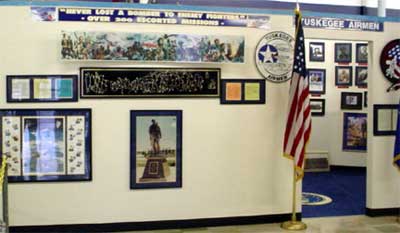
Tuskegee Airmen Exhibit
Lt. Col. James C. Warren who began his career as one of the original Tuskegee Airmen created this comprehensive exhibit. He enlisted in the U.S. Army Air Forces in November 1942 and retired with the rank of Lt. Colonel in 1978. He served in WWII in the 477th Bombardment Group (medium) and flew more than 173 combat missions, including the Korean and Vietnam wars. Awards include the DFC with 2 Oak Leaf Clusters, Air Medal with 11 Oak Leaf Clusters, 3 Meritorious Service Medals and Air Force Commendation Medal. He is the author of Tuskegee Mutiny at Freeman Field.
The “Tuskegee Airmen” was the popular name of a group of African American pilots who flew with distinction for the United States Army Air Forces during World War II. Before and during World War II, the armed forces of the United States, like much of American society, were segregated by race. Historically, most African American soldiers and sailors were relegated to support functions rather than combat roles, with few opportunities to advance to command positions.
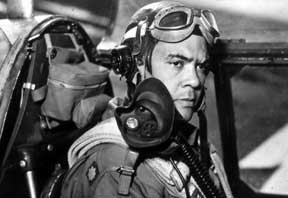
Colonel Benjamin O. Davis, Jr., the first African-American to fly solo as an officer
In 1940, in response to pressure from prominent African American leaders such as A. Philip Randolph and Walter White, President Franklin D. Roosevelt opened the United States Army Air Corps (after 1941, the United States Army Air Forces) to black men who volunteered to train as fighter pilots. The first of the black units, the 99th Fighter Squadron, trained at an airfield in Tuskegee, Alabama, which gave rise to the name "Tuskegee Airmen" as a blanket term for the Army's black aviators. Under the command of Colonel Benjamin O. Davis, Jr., the first African-American to fly solo as an officer, the 99th saw action in North Africa and Italy in 1943. In 1944, the 99th was merged with three other black squadrons to form the 332nd Fighter Group.
WASPS
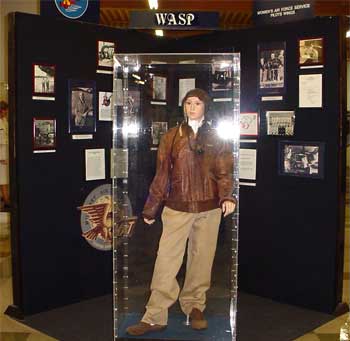
Women in World War II Exhibit
In September 1942, the Women's Auxiliary Ferrying Squadron (WAFS), composed of women flyers with commercial licenses, was activated under Mrs. Nancy Harkness Love to ferry aircraft. Almost simultaneously, the Women's Flying Training Detachment was created under the leadership of the famed aviatrix Jaqueline Cochran to recruit and train women pilots for ferrying duties. On August 5, 1943, the two organizations merged into a single unit, the WASP, with Miss Cochran as Director of Women Pilots. Members of the WASPs were civil service employees.
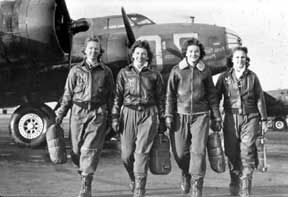
“Off we go into the wild blue yonder . . .”
By Dec. 1944, the critical shortage of male pilots had ended and the WASP program was terminated. A total of 25,000 women had applied for WASP training. 1,830 had been accepted, and 1,074 had graduated and been assigned to flight duty. General H.H. Arnold once stated that it became common for commanding officers to prefer WASPs over male ferry pilots since the women pilots did not carry 'address books' and often reached their destination sooner than the male pilots.
“Fat Man” Nuclear Bomb

“Fat Man” Nuclear Bomb
A "Fat Man" bomb was dropped over Nagasaki, Japan, on August 9, 1945 near the end of WWII. Released by the B-29 "Bockscar" on display in the USAF Museum's Air Power Gallery, the 10,000-pound weapon was detonated at an altitude of about 1,800 feet over the city. The bomb had an explosive force (yield) of about 20,000 tons of TNT, about the same as the bomb dropped on Hiroshima. But because of Nagasaki's hilly terrain, the damage was somewhat less extensive than at relatively flat Hiroshima. "Fat Man" was an implosion type weapon using plutonium. A sub-critical sphere of plutonium was placed in the center of a hollow sphere of high explosive (HE). Numerous detonators located on the surface of the HE were fired simultaneously to produce a powerful inward pressure on the capsule, squeezing it and increasing its density. This resulted in a supercritical condition and a nuclear explosion.
|
|